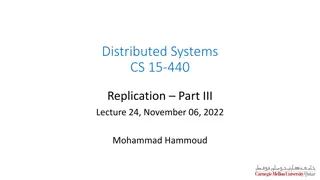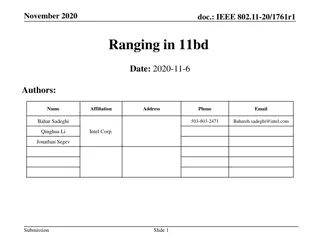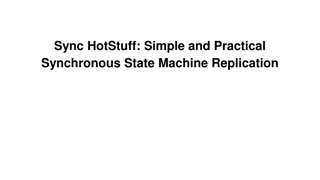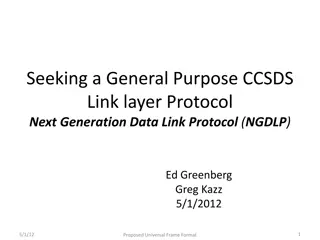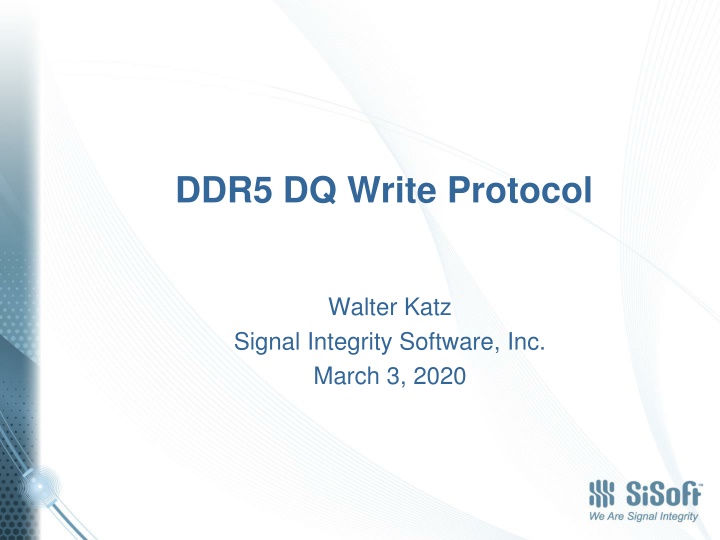
DDR5 DQ Write Protocol and BCI Statistical Methods
Explore the DDR5 DQ Write Protocol and BCI statistical methods for signal integrity in software design. Learn about BCI strings, Tx-Rx communication, setting gains and taps, VrefDQ and DFE handling, and more. Get insights into how Rx responds to Tx instructions in a comprehensive overview.
Download Presentation

Please find below an Image/Link to download the presentation.
The content on the website is provided AS IS for your information and personal use only. It may not be sold, licensed, or shared on other websites without obtaining consent from the author. If you encounter any issues during the download, it is possible that the publisher has removed the file from their server.
You are allowed to download the files provided on this website for personal or commercial use, subject to the condition that they are used lawfully. All files are the property of their respective owners.
The content on the website is provided AS IS for your information and personal use only. It may not be sold, licensed, or shared on other websites without obtaining consent from the author.
E N D
Presentation Transcript
DDR5 DQ Write Protocol Walter Katz Signal Integrity Software, Inc. March 3, 2020
Overview BCI Statistical Methods BCI DDR5 DQ Write Protocol based on iterating AMI_Impulse and AMI_GetWave 2
(BCI ) String for DDR5 DQ Write Protocol AMI_Impulse has two arguments used to communicate between the Tx and Rx **BCI_parameters_out Used to communicate to the other end * BCI_parameters_in Used to communicate from the other end The EDA tool is responsible for setting *BCI_parameters_in to the **BCI_parameters_out of the other end (BCI ) strings use same parameter tree format as in **AMI_parameters_out and *AMI_parameters_out EDA tools need not parse this string (but could for parse it and report debug information as QCD does for GetWave) Some communications (e.g. Rx AMI_Impulse to Tx AMI_GetWave may require BCI_ID file I/O. 3
Tx (BCI ) Output | Tx tells Rx how to set its gain and taps (BCI (Sequence <sequence #>) (From Tx ) (BCI_State Training|Converged ) (Gain <gain register>) (VrefDQ <VrefDQ register>) | Integer, (Range 32 -1 63) (VrefDQ _V <VrefDQ Vref>) | Float, (Range 0.6 0.4 0.8) (DFE1 <tap1 register>) (DFE2 <tap2 register>) (DFE3 <tap3 register>) (DFE4 <tap4 register>) (DFE1_V <tap1 coefficient>) | Float, (Range 0.0 -0.200 0.50) (DFE2_V <tap2 coefficient>) | Float, (Range 0.0 -0.075 0.075) (DFE3_V <tap3 coefficient>) | Float, (Range 0.0 -0.060 0.060) (DFE4_V <tap4 coefficient>) | Float, (Range 0.0 -0.045 0.045)) | Integer, (Range 0 -3 3) | Integer, (Range 0 -40 10) | Integer, (Range 0 -15 15) | Integer, (Range 0 -12 12) | Integer, (Range 0 -9 9) (BCI(Sequence 1) (From Tx ) (BCI_State Training ) (Gain 0) (VrefDQ -1)(DFE1 0 ) (DFE2 0 ) (DFE3 0 ) (DFE4 0)) 4
VrefDQ and DFE Taps Can be Integer Index Register or Floating Voltage Value It is up to the Tx whether to specify DFE taps as integer register values or DFE coefficient voltage values. It is up to the Tx whether to specify VrefDQ as an integer register value or float voltage. The Rx must be able to support both methods. Note that to support using VrefDQ, the Rx model must have DC_Offset in its .AMI file. If the Tx specifies Index Resister values, the Rx would return the voltage values used. If the Tx specifies float voltage values, the Rx would return the integer index values used. 5
Rx (BCI ) Output | Rx sets up Gain and DFE taps from Tx instructions in Tx (BCI ) | Rx tells Tx what it did with the following (BCI ) (BCI (Sequence <sequence>) (From Rx ) (BCI_State Training ) (BER <used BER>) | May be > 1e-16, if no 1e-16 contour (VrefDQ <VrefDQ used by Rx when input VrefDQ = -1>) (VrefDQ <VrefDQ register>) (VrefDQ _V <VrefDQ Vref>) (DFE1 <tap1 register>) (DFE2 <tap2 register>) (DFE3 <tap3 register>) (DFE4 <tap4 register>) (DFE1_V <tap1 coefficient>) (DFE2_V <tap2 coefficient>) (DFE3_V <tap3 coefficient>) (DFE4_V <tap4 coefficient>) (Eye_Height <eye height at used BER>) (Eye_Width <eye width at used BER>) (Eye_Area <eye area at used BER>) ) | Integer, (Range 32 -1 63) | Float, (Range 0.6 0.4 0.8) | Integer, (Range 0 -40 10) | Integer, (Range 0 -15 15) | Integer, (Range 0 -12 12) | Integer, (Range 0 -9 9)) | Float, (Range 0.0 -0.200 0.50) | Float, (Range 0.0 -0.075 0.075) | Float, (Range 0.0 -0.060 0.060) | Float, (Range 0.0 -0.045 0.045))\ (BCI (Sequence 1) (BCI_State Training ) (From Rx ) (BER 1e-16) (VrefDQ 32) (VrefDQ_V 0.6) (DFE1_V 0.0 ) (DFE2_V 0.0 ) (DFE3_V 0.0 ) (DFE4_V 0.0 ) (Eye_Height .3) (Eye_Width 50e-12) (Eye_Area 30e-12) ) 6
This is All There Is This is the extent of the DDR5 DQ Write Protocol The protocol will include a detail method for the Rx to calculate the Eye Height and Eye Area Metrics from an Impulse Response Memory and Controller vendors may want to add jitter and noise impairments to the protocol Memory and Controller vendors may want to add additional or alternative metrics 7


